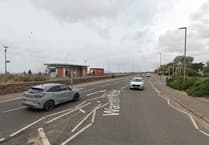SWIMMERS were being warned this week not to use beaches in Minehead and Dunster after weekend storms resulted in a risk of pollution in the sea.
The Environment Agency, which monitors water quality daily between May and September, said heavy rain meant the bathing waters were unsafe because they were likely to contain pollutants potentially harmful to people’s health.
It said bathing water quality was affected by the amount of bacteria which was washed into the sea from livestock, sewage, and urban drainage via rivers and streams.
Swimming in the sea in those circumstances could result in people suffering an illness.
An Environment Agency spokesperson said: “When these factors combine to make short-term pollution likely, we issue a pollution risk warning and the beach manager will display a sign advising against bathing at the water.
“After a short-term pollution event, levels of bacteria typically return to normal after a day or so, but it is possible to have several warning days in a row.
“All bathing waters have the potential to be affected by a pollution incident and if this occurs a pollution risk warning will be issued with associated advice against bathing on the Environment Agency website.”
In Minehead, the water off the beach is tested at a location almost opposite the West Somerset Railway Station.
For the past four years the Environment Agency has rated the sea in Minehead as ‘good’ for swimmers.
But on Monday (July 17) the agency advised against bathing due to the risk of pollution, a warning which was receding as the week progressed.
It was a different story for Dunster Beach, where advice against swimming had been in place since last year.
The spokesperson said the agency had been working for a number of years to investigate sources of pollution of Dunster Beach.
“Recent investigation work has been continuing with Wessex Water as part of their investment programme,” they said.
“This includes a review of sewerage performance within the Dunster Bay area to determine what improvements, if any, would be needed to improve bathing water quality further to secure a ‘good’ class and beyond to ‘excellent’.
“These investigations include monitoring the quality of discharges and modelling the potential impact on bathing water quality.
“This is part of a national requirement on all water companies to better understand the impact of their assets on bathing water quality and what future investment might be required to meet ‘good’ and ‘excellent’ standards.
“Our investigations have shown the River Avill can affect bathing water quality during/after heavy rainfall.
“We regularly monitor the quality of the River Avill, generally in conjunction with the bathing water sampling.
“Our officers have walked the catchment to identify and resolve potential sources of pollution including misconnections, poorly maintained private sewerage systems, leaking sewers, and unsuitable farming practices.
“During 2021 and 2022 we used DNA analysis to help us better understand the main sources of contamination at Dunster Beach.
“This technique helps to identify and differentiate between sewage and agricultural sources, dogs, and birds.”
From 2018 to 2021, Dunster Beach was given one star out of three resulting in a rating of ‘sufficient’, which is the same rating Blue Anchor Beach received for the past four years.
By contrast, bathing water in Porlock Weir has been rated with a three-star ‘excellent’ every year since 2018




